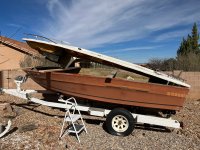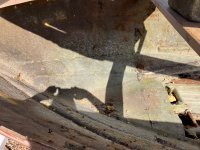Well, got rid of all the cap rivets that had a little aluminum "pin" in them (which filled the little hole in the rivet). Made HUGE holes, to remove those buggers, having to go in at weird angles to get them drilled out. Those pins are impossible to get out, aren't they? My drill bit kept sliding off center while trying to get those rivets out What are those pins for anyways?
Then started cleaning out the space between the cap and hull with my wide metal spreader, removing dirt and silicone sealant. Had a couple places I had to hammer the blade against some remaining pieces of drilled out rivets. Fun! FUN! F U N !!! No, seriously! I'm loving every minute I work on my boat. Even being annoyed like crazy by things like aluminum rivet pins and remaining bits of aluminum rivets is fun. Because I'm getting closer and closer, step by step, to the next goal... which is cap removal!
Hose blasted the space between the cap/hull, to clean out any remaining dirt and loose detritus. So, now we can get back to measuring the hull for three more 2x2 braces! Yay!
Thankfully, I have the rubrail insert all in one piece. So no need to try and measure 5 individual pieces of aluminum rub rail track and add them up!

BTW, any suggestions as to what brand/kind of rub rail I should go with, when I come back to that point in this reconstruction? This was just a 5-piece aluminum rub rail track with a rusty brown-colored insert. So very 80's.

It's about 1.25" wide and I don't think depth (how far it sticks out from the boat) really matters, but I think it was around 1" or so (track+insert).

































